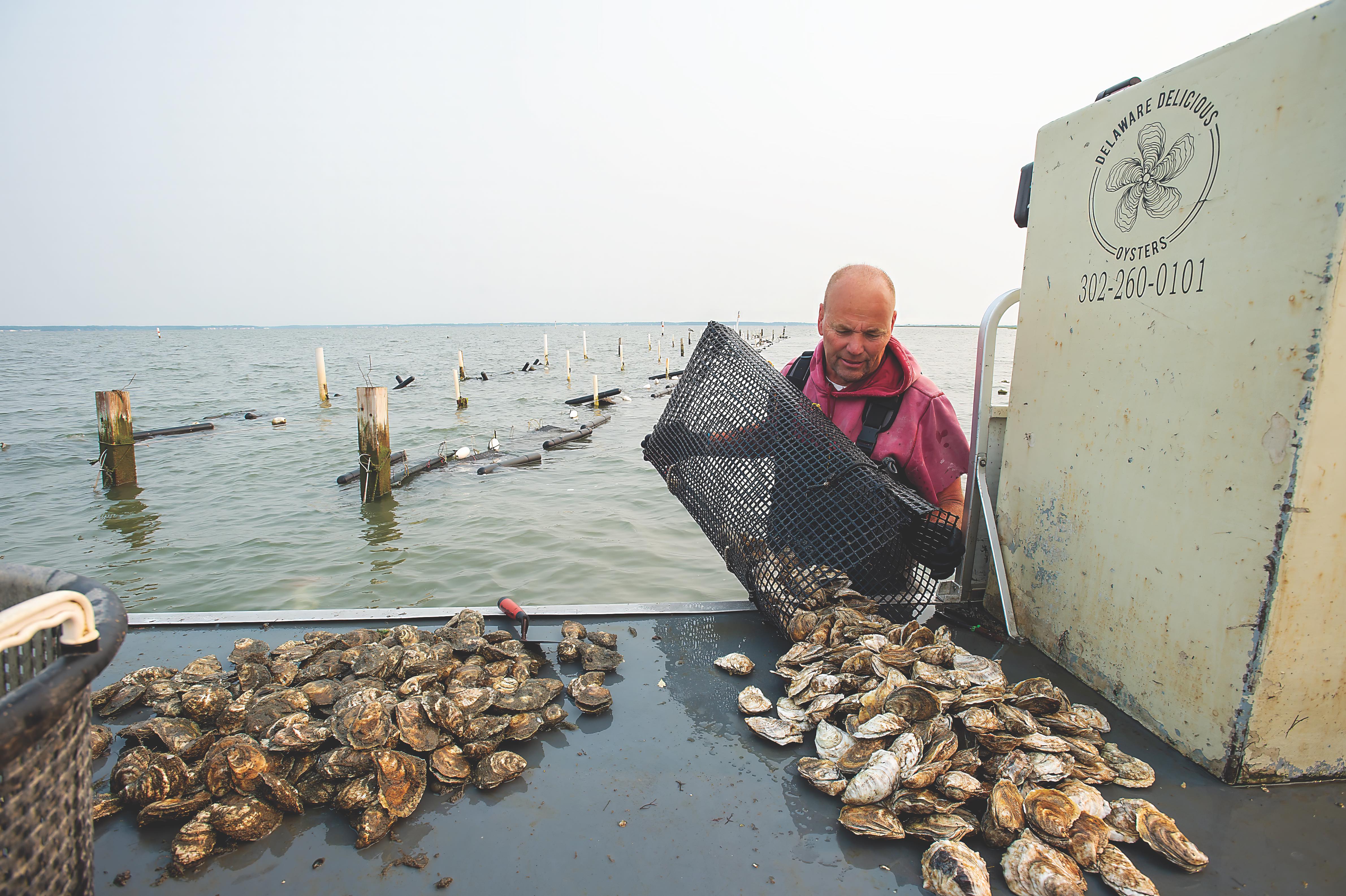
Oyster hatchery may be the first step in revitalizing a lost industry
By Maddie Lauria
Photograph by Scott Nathan
From the August 2023 issue

In a nondescript building along the banks of the Broadkill River in Lewes, roughly 1 million babies were born on a warm May day. Not human babies, of course, but baby oysters that could one day thrive in Delaware’s coastal waters.
These budding shellfish are the offspring of a years-long effort to bring a basic component to a fledgling oyster aquaculture industry. They are the first batch spawned in a new hatchery that experts hope will serve Delaware’s growing shellfish aquaculture industry as well as support oyster restoration efforts in Rehoboth and Indian River bays as well as Delaware Bay.
“It’s a really huge deal, actually,” says Ed Hale, a University of Delaware assistant professor with the Delaware Sea Grant College Program. “It represents a level of maturation with our industry, because we’re trying to help them get to a certain level where they’re growing. … It very much is this nexus between industry and academic research.”
What began as a makeshift hatchery in a storage van in 2020 is now the precursor to what Hale hopes will someday become the Fisheries and Aquaculture Innovation Center, which will be housed elsewhere and supported by the university and its College of Earth, Ocean & Environment.
Even though Delaware is among the last of the East Coast states to start an official aquaculture industry, there are vast possibilities for growth, with more than 300 acres still available to lease for shellfish harvesting in the inland bays. While the larger vision of a full Innovation Center may still be years away (that planning effort is just getting started), the new, pilot-scale hatchery along the northern end of Pilottown Road could help restore a cultural emblem of coastal Delaware life and improve water quality around the state’s most popular summertime vacation havens.
A growing need for seed
The eastern edge of Rehoboth Bay, right behind the Old Inlet Bait & Tackle Shop in Delaware Seashore State Park, is where Jesse Atkinson starts and ends most of his days during the summer.
The Harbeson resident farms three acres of water filled with hundreds of thousands of swiftly growing oysters, which he markets through his company, Delaware Delicious Oysters. As they grow, the bivalves filter nutrients and sediment while plumping up as they feed off the tiny plankton passing through their shells.
“They’re really a top-notch product that’s coming out of Rehoboth Bay,” Atkinson says, describing them as a salty, creamy delicacy flavored by the influx of seawater from the nearby Atlantic Ocean. “A lot of people are really tickled with the oyster.”
Launching a business right as the COVID-19 pandemic shut down local restaurants wasn’t the easiest way to start selling a product, especially after years of battling neighbors’ “not in my backyard” attitudes toward reviving the industry, as well as a slow start to the state’s granting of formal leases. Atkinson said having an in-state hatchery would not only save costs on disease testing (all individual baby oysters, known as “seed,” purchased from out-of-state sources are subject to strict regulations regarding pathogens), but it would also save time. The state’s required testing on these imports can add an additional month or more to the process of growing oysters, which typically takes about one to two years. And the testing costs hundreds or even thousands of dollars for each batch received, on top of the massive investments needed for equipment, insurance and purchasing the seed itself.
All of the oysters grown by Atkinson and a handful of other local aquaculturists are sourced mainly from hatcheries in Virginia and New Jersey, as well as New England.
Carol Friend, whose family has a long history of harvesting local shellfish, also said she’d love to see the new hatchery fully operational to streamline the process of planting oysters in the bays.
“I just want them to get it up and going,” says Friend, who owns the Salty Witch Oyster Company and works in tandem with the growers behind the Rehoboth Bay Oyster Company. After three or four years of growing oysters in the bays, the retired U.S. Postal Service worker has seen the price of seed double since last year, and she hopes that having locally sourced product would help improve her bottom line.
Her brother, Steve Friend, a retired clammer and aquaculturist, joined forces with other local residents as “community liaisons” advocating the industry’s growth as a way to restore water quality in the inland bays. The group includes Rick Chamberlin, a former Delaware state trooper who doesn’t grow oysters but wants to see aquaculture in the inland bays thrive.
In recent years, these concerned residents and the state’s handful of shellfish experts educated state legislators about the hatchery and ultimately secured about $300,000 from the Delaware General Assembly to get the project started. With another $246,000 in community grants, the team was on its way to building the East Coast’s 41st oyster hatchery — and the first in Delaware — to support research, nonprofit and commercial interests, as well as planning the Innovation Center. The project got another boost in June, when lawmakers approved an additional $1.1 million in funding.
Restoring waterways and a way of life
The new hatchery’s site was once a ramshackle setup used for experimental oyster research purposes in the 1990s. Now, thanks to about $75,000 in upgrades, the two-room, one-story building is split between studies on apex predators like coastal sharks and the hatchery operation that includes water intakes, filtration and outputs, adult oysters, tanks filled with algae and five 600-liter tanks resembling those found in a brewery — except they’ll hold water with oyster larvae instead of craft beer.
On an afternoon in May, the river water flowing over the few dozen oysters in the hatchery is 65 degrees, approaching the optimal temperature for spawning. As a handful of holding trays drained, allowing a closer look at the adult bivalves at the facility, some of the oysters spit out water as if in anger, wondering why their food supply had been cut short. The next day, Alyssa Campbell, the laboratory’s coordinator, selects just a few of those shellfish — four females and one male — to create a new generation of carefully raised Eastern oysters.
Campbell explains that oysters are “broadcast spawners”: When the time is right — largely depending on water temperature, not love being in the air — the shellfish will eject their sperm and eggs, allowing them to mix loosely in the aquatic environment. The tide and currents then carry away the microscopic larvae to settle where they may.
In this more lab-like setting near Lewes, those five oysters were shucked and their reproductive organs removed in order to re-create that natural process in a controlled space. About 4 million eggs were collected and, within about 45 minutes, were fertilized. The following morning, about 1 million of those “trochophores” developed into swimming, empanada-shaped larvae measuring about the width of a human hair. At this stage, the microscopic oysters are ready to eat cultured algae, which is just like baby food for them, Campbell notes.
Once the larvae grow a foot-like organ and start looking for a place to settle down, Campbell will introduce them to oyster shells or grains of sand for them to stick to. After the babies adhere to shells in clumps, they’re known as oyster “spat,” and will be used for water restoration purposes. The oyster larvae individually set on grains of sand will become “oyster seed,” which is what commercial growers want, as soon as they’re about the size of a fingernail.
All of the oysters produced in this first year will likely be donated, Campbell expects. Some will be offered to growers while others will go toward restoration projects led by such organizations as the University of Delaware or the Delaware Center for the Inland Bays, which uses the shellfish for oyster reef projects and shoreline stabilization methods. (The latter include “living shorelines,” which use natural and nature-based materials to offset and prevent erosion.)
“Shellfish are important to the inland bays, so the center is eager to help further the aquaculture industry, and [it] feels the hatchery helps do exactly that,” says Anna Fagan, the CIB’s deputy director. The organization played a pivotal role in helping develop legislation supporting aquaculture in the inland bays and also established the Inland Bays Shellfish Aquaculture Tiger Team, which has offered scientific input regarding the challenges and possibilities of developing this new industry. In 2021, the CIB’s Citizens Advisory Committee and board of directors pushed a resolution that supported the hatchery’s efforts as well as the larger planned Fisheries and Aquaculture Innovation Center.
“We care about oysters because they are a super vital part of a healthy inland bays ecosystem,” Fagan says. “They’re also important to regional heritage and economics. Not only do oysters improve water quality, but they actually have a rich history as a healthy commercial industry.”
Delaware’s ‘white gold’
While the modern aquaculture industry in the inland bays only started planting oysters in 2017, harvesting and eating shellfish from local waters has a storied history in Delaware. The area’s earliest Native Americans feasted on them and used their shells in everyday life, such as to make jewelry, as evidenced by displays at the Nanticoke Indian Museum near Millsboro.
After the European settlement of the region, these marine riches were wrested away and an industry built around oysters in the 19th and early 20th centuries eventually trumpeted the bivalves as “white gold.” In the early 1900s, oyster-based fare was as common and plentiful as what’s sold today from hot dog carts on U.S. city streets. However, the plentiful oysters in both the inland bays and Delaware Bay fell victim to both overharvesting and parasitic disease. By the late 1950s, their numbers had plummeted.
“Our maritime history is commercial fishing and commercial oysters,” says Dennis McIntosh, a professor and extension specialist with the aquaculture program at Delaware State University and also the hatchery’s designer. “People using it now for rentals and vacations don’t want to hear about commercial activities taking place. … [But] this is a commercial industry with a net-positive impact on the environment, with great-tasting oysters coming out of this local system.”
But that local source of “white gold” has actually been gone so long that it’s no longer known if a true local oyster even exists anymore, notes McIntosh, who is also affiliated with the Delaware Sea Grant College Program. He says many of the oysters now growing in the inland bays are descendants of those purchased from Rutgers University for use in restoration projects.
This year marks a decade since Delaware enacted a law creating a new aquaculture industry in the inland bays. “The industry has been plugging along,” McIntosh says, noting that regulations on how many oysters must be planted and the disease testing requirements have posed challenges. “Having a hatchery in the state will help overcome that a little bit.”
A new tide of possibilities
On Valentine’s Day this year, Campbell and members of Hale’s lab waded knee-deep into the salty Broadkill River and chiseled oysters off the rocks along the shoreline. That “wild” catch joined the trays of oysters purchased from Rutgers, the latter of which helped spawn the first batch of larvae from the hatchery this summer. The oysters harvested from the rocks will be used for future spawns.
Once the hatchery is fully up and running, it could supply upwards of
35 percent of the inland bays aquaculture needs, says McIntosh. According to the latest report on the new industry, only 23 acres in Rehoboth Bay were leased for shellfish in 2021 — and one of those belongs to the Center for the Inland Bays, for research purposes. According to the CIB’s 2021 State of the Delaware Inland Bays report, the 10 growers working those 22 acres harvested 431,589 oysters that year. The state estimates the small industry’s gross sales were about $300,000.
Of course, that’s just a fraction of what the industry could be in the future. Rhode Island, which has been in the aquaculture business for more than two decades, has similar acreage available to growers, but in 2021 there were nearly 370 acres in active use. From them, nearly 10.2 million oysters were harvested and sold for consumption at a value of $6.9 million, according to the latest report from the state’s Coastal Resources Management Council. Another 4.7 million oysters were deployed to local restoration sites.
The experimental Delaware spawnings this year — which could occur as frequently as twice a month into September, based on the oysters’ seasonal reproductive cycles — will give the state’s modern-day oyster experts and growers a better look at what it takes to produce locally sourced seed.
“We have a big gap. We’re more than 10 years behind the ball,” says Hale, noting that the addition of the hatchery is a small step toward catching up. “What we’re doing is being at the plate with industry and community stakeholders the whole way through.
“For us, that represents a culmination of effort on everybody’s part.”



